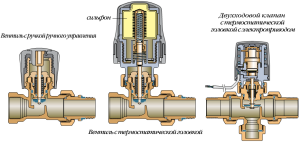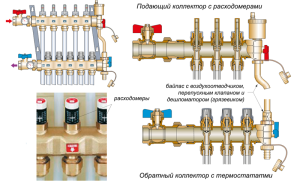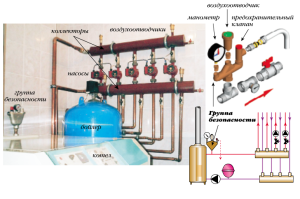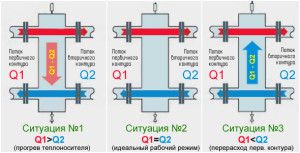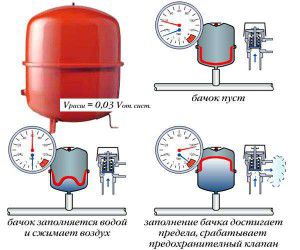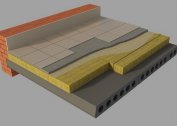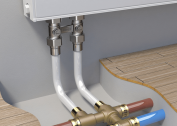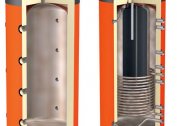During operation of the heating system, it is necessary to change the pressure and temperature of the coolant. This may be due to several factors - overheating of hot water, uneven hydraulic distribution. To solve these problems, it is necessary to install temperature and pressure regulators of the heating system.
Heating temperature control devices
Most often, it is necessary to change the temperature in the heating system. This can be done both comprehensively for the entire network, and for each device individually. Therefore, in critical sections of the highway, a mechanical temperature controller for heating or its electronic analogue is needed.
What tasks should these devices perform? First of all - control and timely change in temperature in the system. Depending on the design and scope of application, temperature regulators for radiators and the entire heat supply as a whole can be of several types:
- Controllers of the entire heating system. These include the weather heating controller, which is connected directly to the boiler or the distribution unit of the system;
- Zone temperature thermostats. This function is performed by the heating battery controller, which limits the flow of coolant depending on the current temperature readings.
Each of these classes of devices is molded constructively and has its own individual installation scheme. Therefore, for the correct configuration of heat supply, it is necessary to understand the specifics of all types of temperature controllers.
Experts recommend purchasing heating radiators with a temperature regulator. This will not only save, but eliminate the likelihood of buying the wrong model.
Mechanical heating thermostats
The mechanical regulator of the heating battery is the simplest and most reliable device for semi-automatic and automatic control of heating of the surface of the radiator. It consists of two interconnected nodes - shutoff valves and control thermal head.
In the case of the control part there is a thermosensitive element that changes its size under the influence of temperature. It is connected to a needle valve restricting the flow of coolant. To control the change in valve position, the heating controller in the apartment has a coil spring, which is connected to the adjustment knob. Its rotation increases or decreases the degree of compression of the spring to the heat-sensitive element, thereby setting the temperature of the device.
The advantages of using a mechanical temperature controller for heating are as follows:
- The ability to adjust the heating of an individual radiator without affecting the parameters of the entire system;
- Easy installation and maintenance. This work can be done not even by a specialist. It is only important to familiarize yourself with the installation instructions for temperature controllers in radiators;
- The design is designed for radiators of all types - steel, aluminum, bimetallic and cast iron. However, installing the controller in a cast-iron heating battery is not always advisable. This material has a high heat capacity.
The main difficulty in installing heating radiators with a temperature controller is the correct location of the control element. Hot air from pipes or batteries must not act on a thermally sensitive element. This will cause it to malfunction.
The installation technology of the mechanical temperature controller for heat supply may vary depending on the design of the battery and how it is connected to heating.
Electronic heating programmers
Significantly greater functionality is possessed by weather heating regulators. They consist of an electronic control unit that can be connected to other heat supply elements - a boiler, temperature regulators, circulation pumps.
The principle of operation of electronic heating controllers in an apartment is different from mechanical ones. They process the readings of internal or external thermometers to transmit commands to control elements. So, when the temperature in a separate room changes, a command is sent to the servo drive of the heating radiator regulator, which in turn changes the position of the needle valve.
The specifics of the functioning of the weather heat supply regulator is expressed in the following nuances:
- Providing a constant supply of electricity for the operation of the device;
- Connection to other heating elements can be made if the device of the heating controller in the apartment has the corresponding connectors;
- Changing the parameters of the controller depends on the factory settings. Some models for heat radiators with a temperature controller have fixed settings. Complex programmers are distinguished by flexible software.
To organize remote control of the heating controller in the house, you can install the GPS module. With it, data on the state of the system will be transmitted to the user in the form of SMS. In the same way, reverse heat supply is controlled. The manual heating temperature controller does not have this function a priori.
Setting the temperature controllers for heating radiators is based on the calculated parameters of the system. Otherwise, the device may not function properly.
Temperature regulators in heating collectors
In addition to installing manual heating temperature controllers in the batteries, they are used to complete the collector heat supply. Their installation is carried out both in the central distribution combs and in the control unit of the underfloor heating system.
Unlike regulators for heating radiators, in the collector group they perform the function of controlling the volume of the coolant flow into individual heat supply circuits. Therefore, the requirements for the design and its functionality are slightly higher than for devices designed to complete batteries.
There are several types of temperature regulators for collector groups:
- Manual heat supply temperature controllers. Structurally, they are no different from similar devices for batteries. The difference in the size of the connected pipe and the temperature range of operation. In operation, they are inconvenient, since you have to manually configure the parameters for an individual circuit;
- Servo-controlled thermostats. Often they are connected to an external control module. Changing the position of the shutter occurs only when a command is received from the programmer. Options with the installation of an external temperature sensor are possible. This is most often done to organize mixing units.
Installation and operation of such temperature controllers will allow to achieve fine tuning of individual circuits in heating. Thus, it is possible to save on costs for the use of energy and optimize the operation of the entire system as a whole.
There are two types of thermostats for collector heating - with removable servos and stationary. The choice depends on the required system functionality.
Heating pressure regulators
In a closed heat supply system, in addition to temperature, there is another equally important indicator - pressure.As a result of heating the coolant, it expands. On the one hand, this phenomenon contributes to a better circulation of hot water. But if you do not install a pressure regulator for heating, an emergency may occur.
The normal value of this parameter ranges from 2 to 5 atm. depending on the type of heating system. In centralized highways, a short-term excess of pressure up to 10 atm is possible. The pressure regulator of the heating system is designed to stabilize it.
Currently, there are several types of these devices that differ not only in appearance, but also in functionality:
- Drain valve. Removes excess coolant to compensate for pressure;
- Air vent. Designed for the timely elimination of air jams. They are formed due to overheating of hot water and can lead to emergencies;
- Water gun. This regulator of water pressure in the heating system is used not only for collector systems, but also in two-pipe schemes. It stabilizes the pressure between the supply and return pipes of the heat supply.
In addition to the hydraulic arrow, all other devices for regulating the water pressure in the heating system have variable response parameters. Those. the user can set pressure limits himself, at the appearance of which the regulating element is activated.
Expansion tank for stabilizing the heating pressure
A key influence on the stability of a closed heating system with forced circulation has an expansion tank. It is designed to automatically compensate for excessive pressure on pipes and radiators.
Structurally, this device for regulating the pressure in heating is a container divided into two parts by an elastic membrane. One of the cavities is connected to the heating using a pipe, and air is pumped into the second. In this case, the pressure in the second should be less than the maximum allowable by 5-10%.
The principle of operation of the membrane pressure regulator of the heating system can be described by the following algorithm:
- The pressure in the system is normal - the membrane does not change its position.
- A critical expansion of the coolant has occurred. At the same time, the membrane shifts towards the air chamber, thereby increasing the total heat supply. Compensation for overpressure occurs.
- A sharp drop in the volume of coolant. The water pressure regulator in the heating reduces the volume by moving the membrane towards the water chamber. This occurs under the pressure of the air chamber.
In this way, the pressure in the heating system is automatically regulated. When choosing a model of an expansion tank, it is necessary to consider the possibility of replacing the elastic membrane. There are models where the user himself can do this. But for tanks with a small volume, this is not possible. After two or three seasons of operation, you have to dismantle the old heating module and install a new one.
How to calculate the parameters of devices for regulating the pressure and temperature of heating? For this, it is recommended to use specialized software systems. Preliminarily, the characteristics of the house (degree of insulation), a graphical layout of the pipes, radiators and other components of the heat supply are introduced. Based on the data received, the program will give the optimal parameters of all elements.
In the video material, you can familiarize yourself with the specifics of connecting a room temperature controller in heating:

